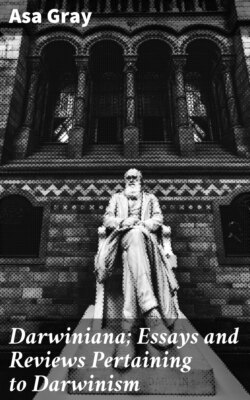Darwiniana; Essays and Reviews Pertaining to Darwinism

Реклама. ООО «ЛитРес», ИНН: 7719571260.
Оглавление
Gray Asa. Darwiniana; Essays and Reviews Pertaining to Darwinism
Darwiniana; Essays and Reviews Pertaining to Darwinism
Table of Contents
DARWINIANA. PREFACE. ARTICLE I. THE ORIGIN OF SPECIES BY MEANS OF NATURAL SELECTION
ARTICLE II. DESIGN VERSUS NECESSITY— A DISCUSSION
ARTICLE III. NATURAL SELECTION NOT INCONSISTENT WITH NATURAL THEOLOGY. PART I.—Premonitions of Darwinism.—A Proper Subject for Speculation.—Summary of Facts and Ideas suggestive of Hypotheses of Derivation. Part II—Limitations of Theory conceded by Darwin.—What Darwinism explains.—Geological Argument strong in the Tertiary Period.— Correspondence between Rank and Geological Succession—Difficulties in Classification.—Nature of Affinity.—No Absolute Distinction between Vegetable and Animal Kingdoms.—Individuality.—Gradation. PART III.—Theories contrasted.—Early Arguments against Darwinism.—Philosophical and Theological Objections—Theory may be theistic.—Final Cause not excluded.—Cause of Variation unknown.—Three Views of Efficient Cause compatible with Theism.—Agassiz's Objections of a Philosophical Nature.—Minor Objections.—Conclusion. ARTICLE IV. SPECIES AS TO VARIATION, GEOGRAPHICAL DISTRIBUTION, AND SUCCESSION
ARTICLE V. SEQUOIA AND ITS HISTORY: THE RELATIONS OF NORTH AMERICAN TO NORTHEAST ASIAN AND TO TERTIARY VEGETATION
ARTICLE VI. THE ATTITUDE OF WORKING NATURALISTS TOWARD DARWINISM
ARTICLE VII. EVOLUTION AND THEOLOGY
ARTICLE VIII "WHAT IS DARWINISM?"
ARTICLE IX. CHARLES DARWIN: SKETCH ACCOMPANYING A PORTRAIT IN "NATURE"
ARTICLE X. INSECTIVOROUS PLANTS
ARTICLE XI. INSECTIVOROUS AND CLIMBING PLANTS
ARTICLE XII. DURATION AND ORIGINATION OF RACE AND SPECIES. PART I.—Do Varieties in Plants wear out, or tend to wear out?—The Question considered in the Light of Facts, and in that of the Darwinian Theory.—Conclusion that Races sexually propagated need not die of Old Age.—This Conclusion inferred from the Provisions and Arrangements in Nature to secure Cross-Fertilization of Individuals.— Reference to Mr. Darwin's Development of this View. PART II.—Do Species wear out, and, if not, why not?—Implication of the Darwinian Theory that Species are unlimited in Existence.—Examination of an Opposite Doctrine maintained by Naudin.—Evidence that Species may die out from Inherent Causes only indirect and inferential from Arrangements to secure Wide Breeding—Physiological Import of Sexes—Doubtful whether Sexual Reproduction with Wide Breeding is a Preventive or only a Palliative of Decrepitude in Species.— Darwinian Hypothesis must suppose the Former. ARTICLE XIII. EVOLUTIONARY TELEOLOGY
PREFACE
I
THE ORIGIN OF SPECIES BY MEANS OF. NATURAL SELECTION [I-1]
II. DESIGN VERSUS NECESSITY. DISCUSSION BETWEEN TWO READERS OF DARWIN'S TREATISE ON THE ORIGIN OF SPECIES, UPON ITS NATURAL THEOLOGY
III
NATURAL SELECTION. NOT INCONSISTENT WITH. NATURAL THEOLOGY
I
II
III
SPECIES AS TO VARIATION, GEOGRAPHICAL. DISTRIBUTION, AND SUCCESSION
V. SEQUOIA AND ITS HISTORY. THE RELATIONS OF NORTH AMERICAN. TO NORTHEAST ASIAN AND TO. TERTIARY VEGETATION
SEQUOIA AND ITS HISTORY 173
SEQUOIA AND ITS HISTORY 175
VI
THE ATTITUDE OF. WORKING NATURALISTS. TOWARD DARWINISM [VI-1]
VII
EVOLUTION AND. THEOLOGY [VII-1]
VIII
WHAT IS DARWINISM? [VIII-1]
CHARLES DARWIN: A SKETCH
X
INSECTIVOROUS PLANTS
XI
INSECTIVOROUS AND. CLIMBING PLANTS [XI-1]
XII
DURATION AND. ORIGINATION OF. RACE AND SPECIES— IMPORT OF SEXUAL REPRODUCTION
II
XIII. EVOLUTIONARY TELEOLOGY
Footnote
Отрывок из книги
Asa Gray
Published by Good Press, 2021
.....
The theory of Agassiz regards the origin of species and their present general distribution over the world as equally primordial, equally supernatural; that of Darwin, as equally derivative, equally natural.
The theory of Agassiz, referring as it does the phenomena both of origin and distribution directly to the Divine will—thus removing the latter with the former out of the domain of inductive science (in which efficient cause is not the first, but the last word)—may be said to be theistic to excess. The contrasted theory is not open to this objection. Studying the facts and phenomena in reference to proximate causes, and endeavoring to trace back the series of cause and effect as far as possible, Darwin's aim and processes are strictly scientific, and his endeavor, whether successful or futile, must be regarded as a legitimate attempt to extend the domain of natural or physical science. For, though it well may be that "organic forms have no physical or secondary cause," yet this can be proved only indirectly, by the failure of every attempt to refer the phenomena in question to causal laws. But, however originated, and whatever be thought of Mr. Darwin's arduous undertaking in this respect, it is certain that plants and animals are subject from their birth to physical influences, to which they have to accommodate themselves as they can. How literally they are "born to trouble," and how incessant and severe the struggle for life generally is, the present volume graphically describes. Few will deny that such influences must have gravely affected the range and the association of individuals and species on the earth's surface. Mr. Darwin thinks that, acting upon an inherent predisposition to vary, they have sufficed even to modify the species themselves and produce the present diversity. Mr. Agassiz believes that they have not even affected the geographical range and the actual association of species, still less their forms; but that every adaptation of species to climate, and of species to species, is as aboriginal, and therefore as inexplicable, as are the organic forms themselves.
.....